Breaking News
First AI/ML-Powered Radar Warning Receiver for Fourth-Generation Aircraft.
A new milestone has been reached in the field of electronic warfare with the first flight test of a Radar Warning Receiver (RWR) incorporating artificial intelligence and machine learning (AI/ML) aboard a fourth-generation aircraft. This innovation promises to improve threat detection and enhance crew protection significantly.

An F-16D Fighting Falcon pilot assigned to the 40th Flight Test Squadron flies over the Florida Gulf. (Picture source: RTX)
The Cognitive Algorithm Deployment System (CADS) is at the heart of this breakthrough. This solution combines high-performance graphics processors with a software stack designed for artificial intelligence. As a result, AI/ML models can now run directly on the RWR sensor, without relying on heavy, remote computing systems.
In practice, the system can detect, classify, and prioritize threats in near real-time. Thanks to local processing on the sensor itself, latency is kept to a minimum. Pilots and operators thus gain a decisive advantage in quickly choosing the best tactical response to an increasingly sophisticated array of threats.
Initial tests were conducted aboard an experimental aircraft, followed by a trial on an F-16 at the Air National Guard test range near Tucson, Arizona. During these demonstration flights, the AI-enhanced RWR proved its ability to respond to complex signals, typical of current and future threat environments.
Several AI/ML research institutes and teams, including the Georgia Tech Research Institute and Vadum, Inc., collaborated on the integration of various cognitive algorithms. This “containerized” approach makes it easy to load and run machine learning techniques, making system updates and upgrades faster and more cost-effective.
Building on these results, the development team anticipates large-scale deployment of this technology as early as the beginning of 2025. The aim is to make existing fourth-generation fleets more resilient against emerging threats while paving the way for simpler integration on other airborne platforms.
This new AI-boosted RWR illustrates the trend of moving computing power directly into the field rather than centralizing it in distant data centers. In an operational environment where rapid analysis and reaction are critical, this approach offers several key advantages. On the one hand, it provides near-instant reactivity in detecting and identifying threats, which significantly reduces the risk of critical errors. On the other hand, it enables greater interoperability: AI/ML solutions can be easily updated or replaced without major hardware modifications.
The introduction of this next-generation RWR, which incorporates cognitive algorithms, marks another step toward more autonomous and efficient electronic warfare capabilities. In potential conflict zones where enemy jamming and detection systems are becoming more advanced, having technology that can learn and adapt during missions could offer a decisive tactical edge.
Recent test campaigns on widely used aircraft like the F-16 demonstrate the maturity of the solution. In the future, this technology could be extended to other combat aircraft, whether they are fourth-, fifth-, or even sixth-generation.
With this intelligent RWR, air forces will have a groundbreaking protective tool capable of instantly distinguishing harmless signals from genuine threats. This asset aligns with a broader effort to automate and optimize decision-making processes on the battlefield while reducing the cognitive load on the crew.


























